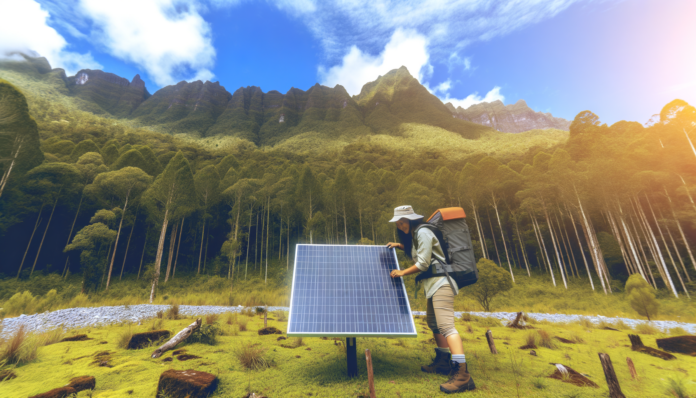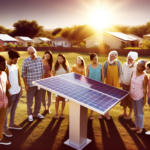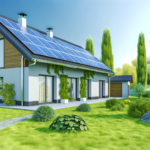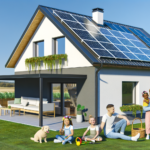Introduction to Solar Panels for Outdoor Adventures
Why Solar Panels are Essential for Outdoor Enthusiasts
For outdoor enthusiasts, the allure of nature often comes with the challenge of staying connected and powered up. Whether you’re camping, hiking, or embarking on a multi-day trek, having a reliable power source is crucial. **Solar panels** offer a sustainable and efficient solution to this problem. They harness the sun’s energy to charge essential gadgets and equipment, ensuring you remain connected, safe, and comfortable during your adventures.
In remote locations where traditional power sources are unavailable, solar panels become indispensable. They provide a way to charge smartphones, GPS devices, cameras, and even portable lights. This not only enhances your safety by keeping communication lines open but also allows you to capture and share your experiences in real-time.
Benefits of Using Solar Panels in Remote Locations
Using solar panels in remote locations offers numerous benefits that make them a must-have for any outdoor adventure:
- Sustainable Power Source: Solar panels provide a renewable and eco-friendly way to generate electricity. By harnessing the sun’s energy, you reduce your reliance on disposable batteries and fuel-powered generators, minimizing your environmental footprint.
- Off-Grid Charging: With solar panels, you can stay off the grid without sacrificing access to essential electronic devices. This is particularly useful for long hikes, camping trips, and expeditions where traditional power sources are not available.
- Cost-Effective: While the initial investment in solar panels may be higher, they offer long-term savings by eliminating the need for disposable batteries and reducing fuel costs for generators.
- Quiet Operation: Unlike noisy generators, solar panels operate silently, allowing you to enjoy the tranquility of nature without any disruptive noise pollution.
- Low Maintenance: Once set up, solar panels require minimal maintenance, making them a hassle-free power solution for outdoor adventures.
Overview of the Article
This article aims to be your ultimate guide to choosing the right solar panels for your outdoor adventures. We will cover everything you need to know, from understanding the technology behind solar panels to assessing your power needs and making an informed purchase. Here’s a brief overview of what you can expect:
- Understanding Solar Panel Technology: Learn how solar panels work, the different types available, and the key components that make up a solar power system.
- Factors to Consider When Choosing Solar Panels: Discover the critical factors to consider, such as power output, efficiency, portability, durability, ease of setup, and cost.
- Assessing Your Power Needs: Find out how to calculate your energy consumption, match solar panel output to your needs, and plan for backup and storage.
- Installation and Maintenance Tips: Get practical advice on setting up your solar panels, maintaining optimal performance, and troubleshooting common issues.
- Maximizing Efficiency and Sustainability: Learn how to position your panels for maximum sunlight, use energy-efficient devices, and integrate solar power with other renewable energy sources.
- Conclusion and Final Thoughts: Recap the key points, explore future trends in solar technology, and encourage you to embrace solar power for your outdoor adventures.
By the end of this guide, you’ll be well-equipped to choose the best solar panels for your needs, ensuring that your outdoor adventures are powered sustainably and efficiently.
Understanding Solar Panel Technology
How Solar Panels Work
Solar panels are a marvel of modern technology, converting sunlight into electricity through a process known as the photovoltaic effect. At the heart of this process are photovoltaic (PV) cells, typically made from silicon. When sunlight hits these cells, it excites electrons, creating an electric current. This direct current (DC) electricity is then captured and can be used to power devices or stored in batteries for later use.
The efficiency of this conversion process depends on several factors, including the quality of the PV cells and the amount of sunlight the panels receive. To maximize efficiency, solar panels are often paired with inverters, which convert the DC electricity into alternating current (AC) electricity, the type used by most household appliances. Additionally, charge controllers are used to regulate the flow of electricity, ensuring that batteries are charged safely and efficiently.
Types of Solar Panels: Monocrystalline, Polycrystalline, and Thin-Film
When choosing solar panels for outdoor adventures, it’s essential to understand the different types available:
- Monocrystalline Solar Panels: These panels are made from a single, continuous crystal structure. They are known for their high efficiency and long lifespan. Monocrystalline panels are typically more expensive but offer the best performance, making them ideal for situations where space and weight are at a premium.
- Polycrystalline Solar Panels: Made from multiple silicon crystals, polycrystalline panels are generally less efficient than monocrystalline panels but are also more affordable. They are a good middle-ground option, offering a balance between cost and performance.
- Thin-Film Solar Panels: These panels are made by depositing one or more layers of photovoltaic material onto a substrate. They are lightweight and flexible, making them highly portable. However, they are less efficient than both monocrystalline and polycrystalline panels and may require more surface area to generate the same amount of power.
Key Components: Panels, Inverters, and Batteries
A complete solar power system for outdoor adventures includes several key components:
- Solar Panels: The primary component that captures sunlight and converts it into electricity. The type and number of panels you choose will depend on your power needs and the space available for installation.
- Inverters: These devices convert the DC electricity generated by the solar panels into AC electricity. Inverters are crucial for powering most electronic devices and appliances. There are different types of inverters, including pure sine wave and modified sine wave, with pure sine wave inverters offering better performance and compatibility with sensitive electronics.
- Batteries: To store the electricity generated by the solar panels, you’ll need batteries. Deep-cycle batteries, such as lithium-ion or lead-acid batteries, are commonly used in solar power systems. These batteries are designed to be discharged and recharged repeatedly, making them ideal for storing solar energy.
Understanding these components and how they work together is crucial for setting up an efficient and reliable solar power system for your outdoor adventures. By choosing the right type of solar panels and ensuring you have the necessary inverters and batteries, you can harness the power of the sun to keep your devices charged and your appliances running, no matter where your adventures take you.
Factors to Consider When Choosing Solar Panels
Power Output and Efficiency
When selecting solar panels for your outdoor adventures, **power output** and **efficiency** are critical factors. The power output, measured in watts, determines how much energy the panel can produce. Higher wattage panels can power more devices or charge batteries faster. Efficiency, on the other hand, refers to how well the panel converts sunlight into usable electricity. Monocrystalline panels typically offer higher efficiency compared to polycrystalline and thin-film panels. For outdoor enthusiasts, choosing a panel with a balance of high power output and efficiency ensures you have a reliable energy source even in less-than-ideal sunlight conditions.
Portability and Weight
**Portability** and **weight** are essential considerations, especially for activities like hiking, camping, or van life where space and weight are at a premium. Lightweight and foldable solar panels are ideal as they can be easily packed and transported. Some panels come with built-in handles or are designed to be rolled up, making them even more convenient to carry. When evaluating portability, also consider the panel’s size when unfolded and its ease of setup. A compact, lightweight panel that is easy to deploy can make a significant difference in your outdoor experience.
Durability and Weather Resistance
Outdoor adventures expose solar panels to various environmental conditions, so **durability** and **weather resistance** are paramount. Look for panels that are built with robust materials and have a high IP (Ingress Protection) rating, indicating resistance to dust and water. Panels with tempered glass and sturdy frames can withstand impacts and harsh weather conditions. Additionally, some panels come with protective coatings to prevent damage from UV rays and saltwater, making them suitable for marine environments. Investing in durable, weather-resistant panels ensures longevity and reliable performance in diverse outdoor settings.
Ease of Setup and Use
The **ease of setup and use** can greatly influence your overall experience with solar panels. Panels that come with user-friendly features such as plug-and-play connectors, integrated stands, and clear instructions are preferable. Some panels include built-in charge controllers and multiple output ports, allowing you to connect various devices directly. Quick and straightforward setup means you can spend more time enjoying your adventure and less time fiddling with equipment. Consider panels that offer intuitive design and minimal setup requirements to enhance convenience and usability.
Cost and Value for Money
**Cost** is always a consideration, but it’s important to evaluate the **value for money** rather than just the initial price. Higher-priced panels often offer better efficiency, durability, and additional features that can justify the investment. When comparing costs, consider the panel’s warranty, as a longer warranty can provide peace of mind and indicate the manufacturer’s confidence in their product. Additionally, factor in the potential savings from reduced reliance on traditional power sources. A well-chosen solar panel can offer significant long-term value by providing a sustainable and reliable energy solution for your outdoor adventures.
Assessing Your Power Needs
Calculating Your Energy Consumption
Before you can choose the right solar panel for your outdoor adventures, it’s crucial to understand your energy consumption. This involves identifying all the devices you plan to use and calculating their total power requirements. Start by listing each device along with its wattage and estimated usage time per day. For example:
- Smartphone: 5W x 4 hours = 20Wh
- LED Lantern: 10W x 6 hours = 60Wh
- Portable Fridge: 50W x 8 hours = 400Wh
- Laptop: 60W x 3 hours = 180Wh
Add up the watt-hours (Wh) for all devices to get your total daily energy consumption. In this example, the total would be 660Wh. This figure will help you determine the size and number of solar panels you’ll need.
Matching Solar Panel Output to Your Needs
Once you have your total daily energy consumption, the next step is to match this with the output of potential solar panels. Solar panels are rated by their wattage, which indicates how much power they can generate under ideal conditions. However, real-world conditions such as weather, shading, and panel orientation can affect their efficiency.
To estimate the actual output, consider the average peak sunlight hours in your location. For instance, if you have 5 peak sunlight hours per day and you choose a 100W solar panel, the daily output would be:
100W x 5 hours = 500Wh
In this scenario, one 100W panel would not be sufficient to meet the 660Wh daily requirement. You would need at least two 100W panels to cover your needs, providing a total of 1000Wh, which also gives you a buffer for less sunny days.
Planning for Backup and Storage
Even with the best planning, there will be days when sunlight is insufficient to meet your energy needs. This is where backup and storage solutions come into play. Batteries are essential for storing excess energy generated during sunny periods, which can then be used during cloudy days or at night.
When choosing a battery, consider its capacity, which is usually measured in ampere-hours (Ah) or watt-hours (Wh). To determine the appropriate battery size, calculate your total energy consumption over the period you want to cover. For example, if you need to store energy for one day (660Wh), a battery with a capacity of at least 660Wh is required. However, it’s advisable to have a larger capacity to account for inefficiencies and future needs.
Additionally, consider the type of battery. Lithium-ion batteries are popular due to their high energy density, longer lifespan, and lighter weight compared to lead-acid batteries. They are more expensive but offer better performance and durability, making them a worthwhile investment for serious outdoor enthusiasts.
In summary, accurately assessing your power needs involves calculating your total energy consumption, matching it with the appropriate solar panel output, and planning for adequate backup and storage. By following these steps, you can ensure a reliable and efficient solar power setup for your outdoor adventures.
Installation and Maintenance Tips
Setting Up Your Solar Panels
Setting up solar panels for your outdoor adventures is a straightforward process, but it requires careful planning and execution to ensure optimal performance. Here are the steps to get you started:
1. **Choose the Right Location**: Select a spot with maximum sunlight exposure. Avoid areas with shade from trees, rocks, or other obstructions. The more direct sunlight your panels receive, the more efficient they will be.
2. **Mounting the Panels**: Depending on your setup, you might use ground mounts, roof mounts, or portable stands. Ensure the panels are securely fastened to withstand wind and other environmental factors. For roof mounts, use brackets and hardware designed for your specific vehicle or structure.
3. **Angle and Orientation**: Position the panels at an angle that maximizes sun exposure. In the northern hemisphere, this typically means facing south. Adjust the tilt based on your latitude to capture the most sunlight throughout the day.
4. **Wiring and Connections**: Connect the solar panels to the charge controller using appropriate cables. Ensure all connections are secure and weatherproof. The charge controller will regulate the power going to your batteries, preventing overcharging.
5. **Connecting to Batteries**: Wire the charge controller to your battery bank. Make sure to follow the manufacturer’s instructions for correct polarity and secure connections. If using an inverter, connect it to the battery to convert DC power to AC for your devices.
Maintaining Optimal Performance
To keep your solar panels operating at peak efficiency, regular maintenance is essential. Here are some tips to ensure your system remains in top condition:
1. **Regular Cleaning**: Dust, dirt, and debris can accumulate on the surface of the panels, reducing their efficiency. Clean the panels with a soft cloth or sponge and mild detergent. Avoid abrasive materials that could scratch the surface.
2. **Inspect for Damage**: Periodically check for cracks, chips, or other damage to the panels. Even minor damage can impact performance. Address any issues promptly to prevent further deterioration.
3. **Check Connections**: Ensure all electrical connections are tight and free from corrosion. Loose or corroded connections can lead to inefficiencies or even system failure.
4. **Monitor Performance**: Use a monitoring system to track the performance of your solar panels. This can help you identify any drops in efficiency and address issues before they become significant problems.
5. **Battery Maintenance**: If your system includes batteries, maintain them according to the manufacturer’s guidelines. This may include checking electrolyte levels, ensuring proper ventilation, and avoiding deep discharges.
Troubleshooting Common Issues
Even with proper setup and maintenance, you may encounter issues with your solar panel system. Here are some common problems and how to address them:
1. **Low Power Output**: If your panels are not generating as much power as expected, check for shading, dirt, or damage. Ensure the panels are positioned correctly and receiving adequate sunlight.
2. **Battery Not Charging**: If the battery isn’t charging, verify the connections between the panels, charge controller, and battery. Check the charge controller settings and ensure it is functioning correctly.
3. **Inverter Issues**: If your inverter isn’t working, check the connections and ensure it is properly wired to the battery. Verify that the inverter is compatible with your system’s voltage and power requirements.
4. **Overheating**: Solar panels can overheat if not properly ventilated. Ensure there is adequate airflow around the panels and that they are not exposed to excessive heat.
5. **System Shutdown**: If the entire system shuts down, check for blown fuses or tripped breakers. Inspect all components for signs of damage or malfunction.
By following these installation and maintenance tips, you can ensure your solar panel system remains efficient and reliable, providing you with a sustainable power source for all your outdoor adventures.
Maximizing Efficiency and Sustainability
Positioning and Angle for Maximum Sunlight
To harness the full potential of your solar panels during outdoor adventures, proper positioning and angling are crucial. Here are some tips to ensure you capture the maximum amount of sunlight:
- Choose the Right Location: Set up your solar panels in an open area with minimal shade. Ideal spots include clearings or south-facing slopes, which receive consistent sunlight throughout the day.
- Adjust the Angle: Tilt your solar panels to face the sun directly. This may require periodic adjustments throughout the day to track the sun’s movement. Early morning and late afternoon are particularly important times to optimize the angle for maximum energy capture.
- Use Reflective Surfaces: Placing your panels near reflective surfaces like water or light-colored rocks can help increase the amount of sunlight they receive.
By following these guidelines, you can significantly boost the efficiency of your solar panels, ensuring a steady supply of power for your devices.
Using Energy-Efficient Devices
Maximizing the efficiency of your solar setup isn’t just about capturing more sunlight; it’s also about using energy wisely. Here are some strategies to make the most of your solar power:
- Prioritize Essential Devices: Focus on charging and using devices that are crucial for your safety and comfort, such as GPS units, communication devices, and lighting.
- Opt for Energy-Efficient Gadgets: Choose devices that consume less power. LED lights, for example, are far more efficient than traditional incandescent bulbs.
- Turn Off Unnecessary Electronics: When not in use, turn off or unplug devices to conserve energy. This simple habit can extend the life of your battery and ensure you have power when you need it most.
By integrating these practices, you can make your solar-powered adventure more sustainable and efficient.
Integrating with Other Renewable Energy Sources
For those looking to further enhance their sustainability, integrating solar panels with other renewable energy sources can be a game-changer. Here are some options to consider:
- Wind Turbines: Portable wind turbines can complement your solar panels, especially in windy locations. They can generate power during cloudy days or at night when solar panels are less effective.
- Hydropower: If you’re camping near a flowing river or stream, small portable hydropower generators can provide a continuous source of energy.
- Battery Storage: Invest in high-capacity batteries to store excess energy generated by your solar panels. This stored energy can be used during periods of low sunlight, ensuring a reliable power supply.
Combining multiple renewable energy sources can provide a more consistent and reliable power supply, making your outdoor adventures more sustainable and enjoyable.
By focusing on optimal positioning, using energy-efficient devices, and integrating other renewable energy sources, you can maximize the efficiency and sustainability of your solar-powered outdoor adventures. Embrace these practices to not only enhance your experience but also minimize your environmental impact.
Conclusion and Final Thoughts
Recap of Key Points
As we conclude this comprehensive guide on choosing solar panels for your outdoor adventures, let’s recap the key points discussed. Solar panels are an essential tool for outdoor enthusiasts, providing a reliable and sustainable power source in remote locations. Understanding the technology behind solar panels, including the different types (monocrystalline, polycrystalline, and thin-film) and key components (panels, inverters, and batteries), is crucial for making an informed decision.
When selecting solar panels, several factors must be considered, such as power output and efficiency, portability and weight, durability and weather resistance, ease of setup and use, and cost. Assessing your power needs by calculating energy consumption and matching it with the solar panel output is vital for ensuring you have enough power for your devices. Additionally, proper installation and maintenance are key to maximizing the efficiency and lifespan of your solar panels.
Future Trends in Solar Technology
The future of solar technology is promising, with continuous advancements aimed at improving efficiency, portability, and integration with other renewable energy sources. Some emerging trends include:
- Higher Efficiency Panels: Research and development are focused on creating solar panels with higher efficiency rates, allowing for more power generation in smaller, more compact designs.
- Flexible and Lightweight Panels: Innovations in materials are leading to the development of flexible and lightweight solar panels that can be easily transported and installed on various surfaces, including curved ones.
- Integrated Energy Storage: Future solar panel systems are likely to feature integrated energy storage solutions, such as advanced batteries, to provide a more seamless and efficient power supply.
- Smart Solar Systems: The integration of smart technology will enable better monitoring and management of solar energy systems, optimizing performance and energy usage.
- Hybrid Systems: Combining solar power with other renewable energy sources, such as wind or hydro, will create more robust and reliable off-grid power solutions.
Encouragement to Embrace Solar Power for Outdoor Adventures
Embracing solar power for your outdoor adventures is not only a practical choice but also a step towards a more sustainable and eco-friendly lifestyle. By harnessing the power of the sun, you can enjoy the freedom and independence of off-grid living while minimizing your environmental impact. Solar panels provide a reliable and renewable energy source, ensuring that you have the power you need for your devices and appliances, no matter where your adventures take you.
Investing in solar technology for your outdoor activities is an investment in the future. It allows you to explore remote locations with confidence, knowing that you have a dependable power source. Moreover, by choosing solar power, you contribute to the global effort to reduce reliance on fossil fuels and promote clean energy solutions.
In conclusion, solar panels are a game-changer for outdoor enthusiasts, offering a sustainable and efficient way to stay powered up during your adventures. With continuous advancements in solar technology, the future looks bright for those who choose to embrace the power of the sun. So, gear up, go solar, and embark on your next outdoor adventure with the confidence that you are making a positive impact on the environment.






